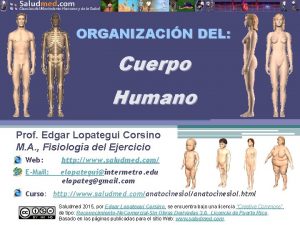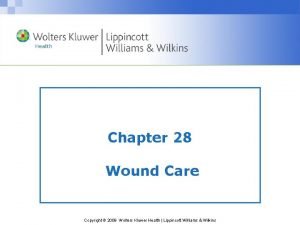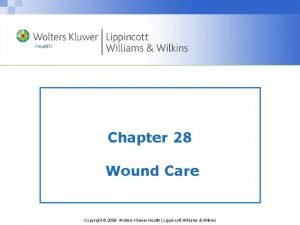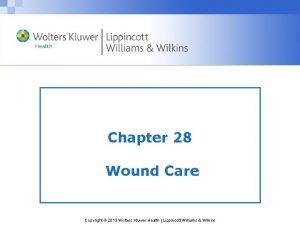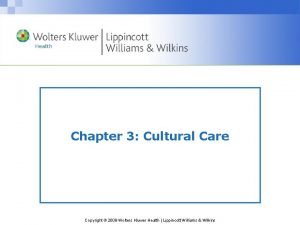Chapter 28 Wound Care Copyright 2009 Wolters Kluwer







- Slides: 7

Chapter 28 Wound Care Copyright © 2009 Wolters Kluwer Health | Lippincott Williams & Wilkins

Dressings (cont’d) • Types of dressings: – Gauze dressings: ideal for covering fresh wounds that are likely to bleed, or wounds that exude drainage – Transparent dressings: used to cover peripheral and central IV insertion sites Copyright © 2009 Wolters Kluwer Health | Lippincott Williams & Wilkins

Dressings (cont’d) • Types of dressings (cont’d) – Hydrocolloid dressings: keep wounds moist; moist wounds heal more quickly; new cells grow more rapidly in a wet environment – Dressing changes: when a wound requires assessment or care Copyright © 2009 Wolters Kluwer Health | Lippincott Williams & Wilkins

Wound Management • Drains – Open drains – Closed drains • Sutures and staples Copyright © 2009 Wolters Kluwer Health | Lippincott Williams & Wilkins

Wound Management (cont’d) • Bandages and binders – Purpose: hold dressings in place, especially if tape cannot be used or dressing is very large – Support area around the wound or injury to reduce pain – Limit movement in wound area to promote healing Copyright © 2009 Wolters Kluwer Health | Lippincott Williams & Wilkins

Wound Management (cont’d) • Roller bandage application • Binder application – Different types of binders o Single T-binder o Double T-binder Copyright © 2009 Wolters Kluwer Health | Lippincott Williams & Wilkins

Nursing Implications • Potential nursing diagnoses: – Acute pain – Impaired skin and tissue integrity – Ineffective tissue perfusion – Risk for infection Copyright © 2009 Wolters Kluwer Health | Lippincott Williams & Wilkins


